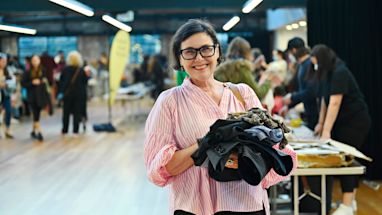If you’ve ever bought second-hand clothes, borrowed a library book or rented an e-bike – you’ve already contributed to the circular economy.
It’s a simple concept: instead of buying something, using it and throwing it out, we design new ways to share and make things last.
While this has incredible environmental and social benefits, it also makes financial sense.
We’ve recently released our circular economy statement, and waste strategy manager Gemma Dawson shares her key takeaways.
“In a circular economy, services are designed for sharing and products are designed for reusing, repairing and refurbishing many times before they need to be recycled.
“For businesses, it starts with creating products that can be used or shared many times. Essentially, it’s about designing out waste.
“Some great examples are movie and music streaming services, instead of DVDs and CDs, car sharing, with the City of Sydney supporting more than 800 car share parking spaces, and composting to regenerate soil and grow more food,” she said.

What we’re doing
At the City of Sydney we support the circular economy in many ways including:
- designing and building new facilities, roads, parks and spaces that are long lasting and use renewable or recycled materials, for example, recycled glass bottles and jars to renew Clarence Street
- composting food waste from our offices and using it in our parks as fertiliser
- hosting community clothes swaps and sewing and repair workshops
- extending traditional libraries to include toys and musical instruments.
We also encourage local businesses to be more circular through grants and education. ReLove received a grant to rescue furniture destined for landfill and provide them to people escaping domestic violence. Dempstah also received a grant to turn unwanted clothing into yarn to make new clothes.

The challenges
While there are challenges to transitioning to a fully circular economy, government, businesses and consumers all have a part to play.
“With the rise of micro-trends and ultra-fast fashion, it’s hard for consumers to make sustainable choices,” Dawson said.
“It’s also often cheaper to buy a new item than repair an old one – like mobile phones, TVs and whitegoods.
“There needs to be more support for industries that repair, refurbish and recycle materials,” she said.
The good news
All levels of government and many industries now recognise the importance of the circular economy and are taking positive steps.
They’re investing millions of dollars in circular initiatives that preserve our limited natural resources, create new jobs and markets, and build community connection.
Find out more in our circular economy statement.
Published 8 August 2024, updated 22 August 2024



